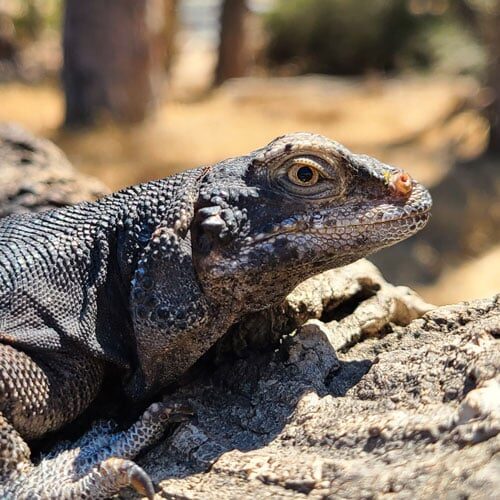ANIMALS
Common Chuckwalla

Latin Name
Sauromalus ater
Common Chuckwalla History
Our female chuckwalla was collected in 2012 by a licensed researcher for a scientific study and then kept at San Francisco State University in the Herpetology department. She was donated to CuriOdyssey in July 2021. At the time of her arrival, she was estimated to be about 9 years old. Our male chuckwalla was captive-hatched at the Oakland Zoo in November 2013 and later transferred to the Sacramento Zoo in 2014. He was transferred to CuriOdyssey in April 2024.
Fun facts about Common Chuckwallas
Chuckwallas rarely drink water, but rather obtain the water they need from plants. They can store water in lymph sacs beneath the folds of skin on the side of the body, and the tail fattens up when resources are plentiful. They also have special glands that filter the salt out of their body, allowing them to produce less urates.
Like many lizards, chuckwallas are capable of autotomy; they can break off and re-grow a tail, if necessary, to evade predation. The common chuckwalla is the second largest lizard in the US (the largest is the Gila Monster).
What do Common Chuckwallas eat?
At CuriOdyssey, we serve our chuckwalla a variety of leafy greens and vegetables; occasionally flowers and insects.
In the wild, chuckwallas eat leaves, fruit, buds and flowers; occasionally insects.
How long to ACommon Chuckwallas live?
In the Wild: 10-30 years, 15 years on average
In Captivity: 25+ years, oldest recorded was 65 years
Where do Common Chuckwallas live?
Chuckwallas are found in desert regions, scrublands, former lava flows, and rocky hillsides. Southwest US and Mexico (especially Mojave and Sonoran deserts), islands in the Gulf of Mexico.
Are Common Chuckwallas endangered?
Considered Species of Least Concern by the ICUN
Chuckwalla populations are very localized and thus very sensitive to habitat degradation. New roads or land developments can separate populations, reduce the amount of available habitat, increase run-off and change water drainage that can flood habitats, and increase pollutants.
The pet trade also poses a threat as over-collection from sub-populations with desired color patterns has been documented to lead to the loss of these populations over time.
SPONSOR AN ANIMAL
Help provide for the care and feeding of our wildlife guests by sponsoring an animal of your choice for a year.
Join the CuriOdyssey Community
LOCATION
1651 Coyote Point Drive
San Mateo, CA 94401
Ohlone Land Acknowledgement
650-342-7755
[email protected]
CuriOdyssey is a 501(c)(3) non-profit, Tax ID 94-1262434

